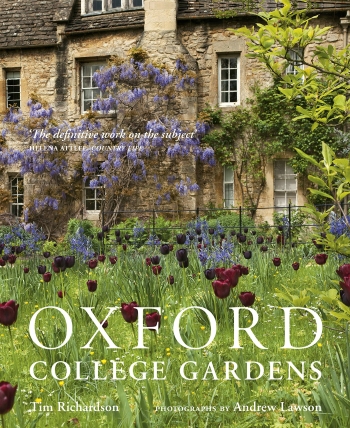Oxford College Gardens and Cambridge College Gardens

|

|
| Oxford College Gardens, Tim Richardson (author) and Andrew Lawson (photographer), White Lion Publishing, 2018, 320 pages, hardback, fully illustrated. | Cambridge College Gardens, Tim Richardson (author), Clive Boursnell and Marcus Harpur (photographers), White Lion Publishing, 2019, 320 pages, hardback, fully illustrated. |
The garden heritage of the Universities of Oxford and Cambridge is now available in two very handsome publications that have been researched and written by a leading garden historian, and illustrated with the work of equally eminent photographers. This is a substantial topic considering the age of most of the colleges and the degree of change that has taken place. The inner cores of the most ancient foundations go back 500 years or more. Richardson finds room for much of the historical background without deviating from the main aim of providing a sumptuous picture book with commentary on the gardens as they are seen today. Descriptions include both architecture and landscape, which are indivisible, and the distinctive character of each of the colleges is analysed on this basis.
The Oxford volume, with 34 chapters, includes the Oxford Botanic Garden – the oldest in Britain, with one of the most extensive plant collections in the world – as well as the colleges. Victorian and more modern colleges are assessed, with reflections on how taste evolved from the classic arrangements of cloisters and lawns to more varied spaces. The volume depicts the vital interplay between buildings and their natural settings. Also addressed is the underlying raison d’être of the gardens: the preservation of calm within college walls and surrounding meadows, such as those of Magdalen, to provide a safer, healthier location for prayer and study in the midst of an urban setting with its bustling streets and marketplaces. Clear maps of each college and a collective map shows how they fit together within the urban form.
The Cambridge volume features 27 gardens. The pair is complementary except that the newer book is on a bigger page format so that the two sit unevenly together on the shelf. The same high praise goes to the author for his research and written fluency. Both books have a selection of David Loggan’s prints and colour pictures of plantings, lawns and trees against backgrounds of quadrangles, college walls, gateways, bridges and water meadows. The styles of planting are wide-ranging, including palms and bananas at Selwyn College and wildflower meadows at Lucy Cavendish College. There are notable trees and great swathes of climbing plants are carefully trained against the ancient college walls.
Yet Cambridge has more than 27 institutions with worthwhile gardens. St Catharine’s College, perhaps the finest of the modern landscapes, is represented in these pages by a single shot only, and Westcott House is a notable absentee among several foundations mainly devoted to religious training (as all the ancient colleges once were). Whether open to the public, or for private use by masters, fellows or porters, and whether traditional or innovative, these gardens share one thing in common: their importance as places for improving the quality of life of their communities.
This article originally appeared as ‘Study and prayer’ in Context 167, published by the Institute of Historic Building Conservation (IHBC) in March 2021. It was written by Graham Tite, conservation officer.
--Institute of Historic Building Conservation
Related articles on Designing Buildings Wiki
- Cambridge market.
- Conservation.
- Gardens Trust.
- Hardy Plants and Plantings for Repton and Late Georgian Gardens (1780-1820).
- IHBC articles.
- Institute of Historic Building Conservation.
- Intensifying development in Oxford.
- Oxford conservation projects.
- Oxford's open spaces.
- Reorganising and conserving Oxford's Mitre site.
- Significance and heritage protection at Cambridge Market.
- The landscapes of Cambridge.
- Walled kitchen gardens of the Isle of Wight.
IHBC NewsBlog
Old Sarum fire in listed (& disputed) WW1 Hangar - Wiltshire Council has sought legal advice after fire engulfed a listed First World War hangar that was embroiled in a lengthy planning dispute.
UK Antarctic Heritage Trust launches ‘Virtual Visit’ website area
The Trust calls on people to 'Immerse yourself in our heritage – Making Antarctica Accessible'
Southend Council pledge to force Kursaal owners to maintain building
The Council has pledged to use ‘every tool in the toolbox’ if urgent repairs are not carried out.
HE’s Research Magazine publishes a major study of the heritage of England’s suburbs
The article traces the long evolution of an internal programme to research 200 years of suburban growth
IHBC Context 183 Wellbeing and Heritage published
The issue explores issues at the intersection of heritage and wellbeing.
SAVE celebrates 50 years of campaigning 1975-2025
SAVE Britain’s Heritage has announced events across the country to celebrate bringing new life to remarkable buildings.
IHBC Annual School 2025 - Shrewsbury 12-14 June
Themed Heritage in Context – Value: Plan: Change, join in-person or online.
200th Anniversary Celebration of the Modern Railway Planned
The Stockton & Darlington Railway opened on September 27, 1825.
Competence Framework Launched for Sustainability in the Built Environment
The Construction Industry Council (CIC) and the Edge have jointly published the framework.
Historic England Launches Wellbeing Strategy for Heritage
Whether through visiting, volunteering, learning or creative practice, engaging with heritage can strengthen confidence, resilience, hope and social connections.















